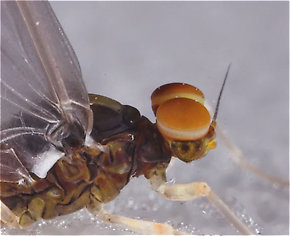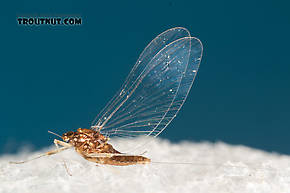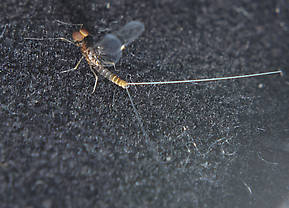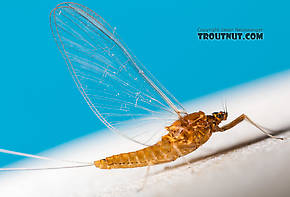Blog & Latest Updates
Fly Fishing Articles
Insects by Common Name


Mayfly Species Acentrella turbida (Tiny Blue-Winged Olive)
Taxonomic Navigation -?-
Kingdom
Animalia (Animals)
» Phylum
Arthropoda (Arthropods)
» Class
Insecta (Insects)
» Order
Ephemeroptera (Mayflies)
» Family
Baetidae (Blue-Winged Olives)
» Species turbida (Tiny Blue-Winged Olive)
Common Names
In the West, turbida is more variable in size and appearance than its eastern iteration, in keeping with the large and varied regions it inhabits. It can run as small as 3.5 mm and as large as 5 mm, the larger sizes tending to be more brownish. It is often confused with the smaller broods of Diphetor hageni, but its conical mesonotal projection (Conical mesonotal projection: small cone shaped spike sticking up from the top and front part of the middle thorax segment.), lack of hind-wings, exaggerated turbinate (

This male Baetidae dun has slightly turbinate eyes.
They are often found on the water with a mix of other Baetidae mayflies, making for very challenging fishing.
Where & When
In Hatches II, Cauci and Nastasi report excellent hatches of this species on Pennsylvania spring creeks, with broods in May, August, and October. They are probably important on similar waters across the country.
Ted Fauceglia's Mayflies mentions Eastern broods of Acentrella hatching from late June to early July and again in September and October, plus a possible earlier brood in late May. Schwiebert mentions in "Nymphs" they can provide excellent fishing in the Fall out West.
Seasonal emergence timing varies from water to water, and these flies may possibly be found at any time of the season depending on locale.
Spinner Behavior
The large turbinate (

This male Baetidae dun has slightly turbinate eyes.
Nymph Biology
The nymphs are stouter in proportion compared to other baetids, but their behavior is similar.
Pictures of 4 Mayfly Specimens in the Species Acentrella turbida:
Female Acentrella turbida (Tiny Blue-Winged Olive) Mayfly Spinner View 12 Pictures
View 12 Pictures
 View 12 Pictures
View 12 PicturesCollected July 17, 2017 from the Middle Fork Snoqualmie River in Washington
Added to Troutnut.com by Troutnut on July 24, 2017
Added to Troutnut.com by Troutnut on July 24, 2017
Male Acentrella turbida (Tiny Blue-Winged Olive) Mayfly Spinner View 3 PicturesI would not like to have to match this hatch. These are the smallest mayflies I have ever seen. I used to think Caenis was the smallest adult mayfly in the west but these guys are about 4mm long. The male eyes are two toned, brown above and olive below. The abdomen is dark brown interspersed with light brown. The abdomen is clear for the anterior (Anterior: Toward the front of an organism's body. The phrase "anterior to" means "in front of.") 2/3rd and the remainder is white. The tails are twice as long as the insect. There is only one pair of wings.
View 3 PicturesI would not like to have to match this hatch. These are the smallest mayflies I have ever seen. I used to think Caenis was the smallest adult mayfly in the west but these guys are about 4mm long. The male eyes are two toned, brown above and olive below. The abdomen is dark brown interspersed with light brown. The abdomen is clear for the anterior (Anterior: Toward the front of an organism's body. The phrase "anterior to" means "in front of.") 2/3rd and the remainder is white. The tails are twice as long as the insect. There is only one pair of wings.
 View 3 PicturesI would not like to have to match this hatch. These are the smallest mayflies I have ever seen. I used to think Caenis was the smallest adult mayfly in the west but these guys are about 4mm long. The male eyes are two toned, brown above and olive below. The abdomen is dark brown interspersed with light brown. The abdomen is clear for the anterior (Anterior: Toward the front of an organism's body. The phrase "anterior to" means "in front of.") 2/3rd and the remainder is white. The tails are twice as long as the insect. There is only one pair of wings.
View 3 PicturesI would not like to have to match this hatch. These are the smallest mayflies I have ever seen. I used to think Caenis was the smallest adult mayfly in the west but these guys are about 4mm long. The male eyes are two toned, brown above and olive below. The abdomen is dark brown interspersed with light brown. The abdomen is clear for the anterior (Anterior: Toward the front of an organism's body. The phrase "anterior to" means "in front of.") 2/3rd and the remainder is white. The tails are twice as long as the insect. There is only one pair of wings.Collected July 27, 2011 from the Touchet River in Washington
Added to Troutnut.com by Bnewell on July 27, 2011
Added to Troutnut.com by Bnewell on July 27, 2011
Female Acentrella turbida (Tiny Blue-Winged Olive) Mayfly Spinner View 3 Pictures
View 3 Pictures
 View 3 Pictures
View 3 PicturesCollected July 17, 2017 from the Middle Fork Snoqualmie River in Washington
Added to Troutnut.com by Troutnut on July 24, 2017
Added to Troutnut.com by Troutnut on July 24, 2017
Your Thoughts On Acentrella turbida:
Top 10 Fly Hatches
Top Gift Shop Designs
Eat mayflies.
Top Insect Specimens
Miscellaneous Sites
Troutnut.com is copyright © 2004-2024 Jason
Neuswanger (email Jason). See my FAQ for information about use of my images.
 privacy policy
privacy policy
